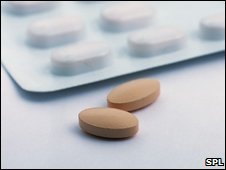| ||||||||||||||||||||||||||||||||||||||||||||||||||||||||||||||||||||||||||||||||||||||||||||||||||||||||||||||||
|
Slow blood flow in areas of the body's arteries1 may reduce the protective effect of statins, research suggests. 研究显示,身体某些部位的动脉血流缓慢可能导致他汀类的保护作用。 The study suggests sluggish2(懒惰的,迟钝的) blood flow tends to hinder(阻碍,打扰) statins' ability to trigger production of beneficial antioxidant(抗氧化剂) molecules3. The body's own protective mechanisms4 also tend to fail in the same areas - leaving them vulnerable to(易受……攻击) damage. The Imperial College London study is featured in the Journal of Biological Chemistry. It raises hopes of new ways to improve general artery5(动脉,主流) health. Statins are estimated to save nearly 10,000 lives a year in England alone by cutting the risk of cardiovascular disease(心血管病). Their primary action is to lower levels of harmful LDL cholesterol6(胆固醇) which can clog7(阻塞) up the arteries. However, they are also thought to stimulate8 production of beneficial antioxidants in the cells of the arteries by boosting levels of a key enzyme9(酶), called heme oxygenase (HO-1). The Imperial team investigated the antioxidant potency(权势) of statins in different parts of the circulation by measuring the amount of HO-1 in the endothelial cells(内皮细胞) that line the arteries. They found the increase in HO-1 induced(感应的) by the statin was significantly higher in cells exposed to fast and regular blood flow than in cells where blood flow was sluggish or disrupted. Previous research has shown endothelial cells produce protective biological signals in parts of the artery where blood flow is fast to counter the build up of fatty cholesterol deposits. But the cells do not react in the same way in areas where blood flow is sluggish. The latest study reveals that statins fail to work well in exactly the same areas where the body's natural defences are weak. Researcher Dr Justin Mason said: "Arteries don't clog up in a uniform way. "Bends and branches of blood vessels11 - where blood flow is disrupted and can be sluggish - are much more prone12 to fatty plaques13(饰板,名牌) building-up and blocking the artery. "What we have shown is that those regions of the arteries most likely to become diseased are the same regions that may not be benefiting maximally from statin treatment - a double whammy(祸不单行)." The researchers hope to find other ways to get the most out of statins, or to find other ways to switch on protective mechanisms in vulnerable areas of arteries. Professor Peter Weissberg, medical director of the British Heart Foundation, which funded the study, said: "This research demonstrates how the physical forces inside blood vessels may influence the local action of drugs such as statins. "The findings open avenues of investigation14 that could lead to greater health benefits of statins' being realised." 点击  收听单词发音 收听单词发音
|
||||||||||||||||||||||||||||||||||||||||||||||||||||||||||||||||||||||||||||||||||||||||||||||||||||||||||||||||
- 发表评论
-
- 最新评论 进入详细评论页>>




